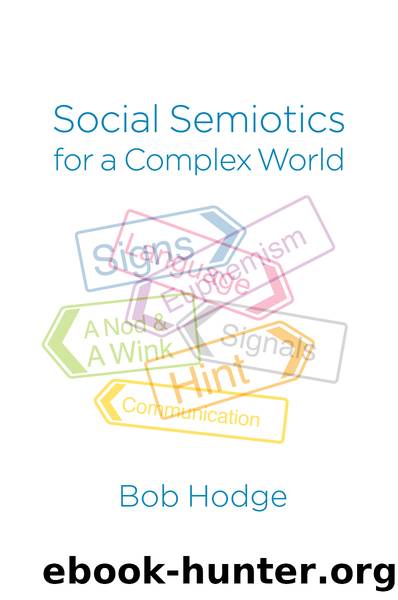Social Semiotics for a Complex World by Bob Hodge

Author:Bob Hodge [Hodge, Bob]
Language: eng
Format: epub
ISBN: 9780745696249
Publisher: Wiley
Published: 2016-10-27T00:00:00+00:00
Wholes and parts
In this section I continue my dual strategy, developing methods of reading to bring out the meaning of key texts about meaning. Here I use this apparatus to look at a sentence of Aristotleâs Metaphysics containing his principle of totality:
5.7 In the case of all things that have several parts and in which the totality is not, as it were, a mere heap, but the whole is something besides the parts, there is a cause. (Aristotle 1935: 1045a8-10)
Aristotleâs sentence contains more than the totality principle (italicized). I begin with the grammatical structure, usually a useful guide to reading. The totality sentence consists of two propositions, a paratactic structure, related by âbutâ, which, as with Wittgenstein, leaves the relation between the two unclear. Each proposition is also a paratactic structure, again related by partial negation. Aristotleâs first negation distinguishes between two forms, a totality and a heap. The meaning at this point is carried at the level of words, not higher-level structures.
The Greek word translated âheapâ is soros, opposed to holon, a similar opposition as English âheapâ versus âwholeâ. In this case differences between the languages are not decisive. What carries and constrains the meanings across languages and epochs is the structure, Wittgensteinâs âscaffoldingâ. Yet in both languages there is the same problem of meaning, the same ambiguity.
This interpretation colours the second statement, often paraphrased as âthe whole is more than the sum of its partsâ. Aristotleâs claim is more ambiguous. The whole is something â i.e., it exists. It is âbesideâ the parts, but they exist also. With both versions of the phrase there is a crucial doubt. Does Aristotle mean that the whole is not the sum of its parts but something completely different? Or does he mean that the whole is both the sum of its parts and also something else?
The difference is huge. In the first interpretation, Aristotle would oppose componential analysis. In the second, he includes it alongside holistic analysis. He invented both logical analysis, which is digital, and holism, so he may be supposed to have entertained both meanings, both pictures, both world views. As we saw, there are fundamental divisions in Wittgenstein also. In both cases, meaning is dialogic, in which different positions or voices co-exist in unresolved, undeclared tension.
In both cases, interpretation (reading) reaches a problem, not a clear meaning. This outcome is not usually desired by beginning readers, yet these questions raise basic issues for the theory and practice of reading as interpretation. Neither outcome â a single interpretation or awareness of complexity â is always right or wrong. But important continuities of skills and knowledge cross these approaches which should find a place in a single reading curriculum.
My analysis is an example of âreading as analysisâ (Carbó 2001), where linguistic analysis, including grammar, is integral to interpreting meanings. Critical reading of this kind is an advanced mode of reading, a legitimate target for a reading programme. It rests on habitual practices of interpretation which include grammar and multimodality, including all the modes by which meaning can be encoded and circulate.
Download
This site does not store any files on its server. We only index and link to content provided by other sites. Please contact the content providers to delete copyright contents if any and email us, we'll remove relevant links or contents immediately.
Cecilia; Or, Memoirs of an Heiress — Volume 1 by Fanny Burney(31335)
Cecilia; Or, Memoirs of an Heiress — Volume 3 by Fanny Burney(30935)
Cecilia; Or, Memoirs of an Heiress — Volume 2 by Fanny Burney(30891)
The Lost Art of Listening by Michael P. Nichols(6474)
We Need to Talk by Celeste Headlee(4871)
Asking the Right Questions: A Guide to Critical Thinking by M. Neil Browne & Stuart M. Keeley(4577)
On Writing A Memoir of the Craft by Stephen King(4216)
Dialogue by Robert McKee(3584)
I Have Something to Say: Mastering the Art of Public Speaking in an Age of Disconnection by John Bowe(3518)
Pre-Suasion: A Revolutionary Way to Influence and Persuade by Robert Cialdini(3416)
Elements of Style 2017 by Richard De A'Morelli(2945)
The Book of Human Emotions by Tiffany Watt Smith(2772)
Good Humor, Bad Taste: A Sociology of the Joke by Kuipers Giselinde(2557)
Name Book, The: Over 10,000 Names--Their Meanings, Origins, and Spiritual Significance by Astoria Dorothy(2492)
Fluent Forever: How to Learn Any Language Fast and Never Forget It by Gabriel Wyner(2447)
The Grammaring Guide to English Grammar with Exercises by Péter Simon(2394)
Why I Write by George Orwell(2360)
The Art Of Deception by Kevin Mitnick(2299)
Don't Sleep, There Are Snakes by Daniel L. Everett(2218)
